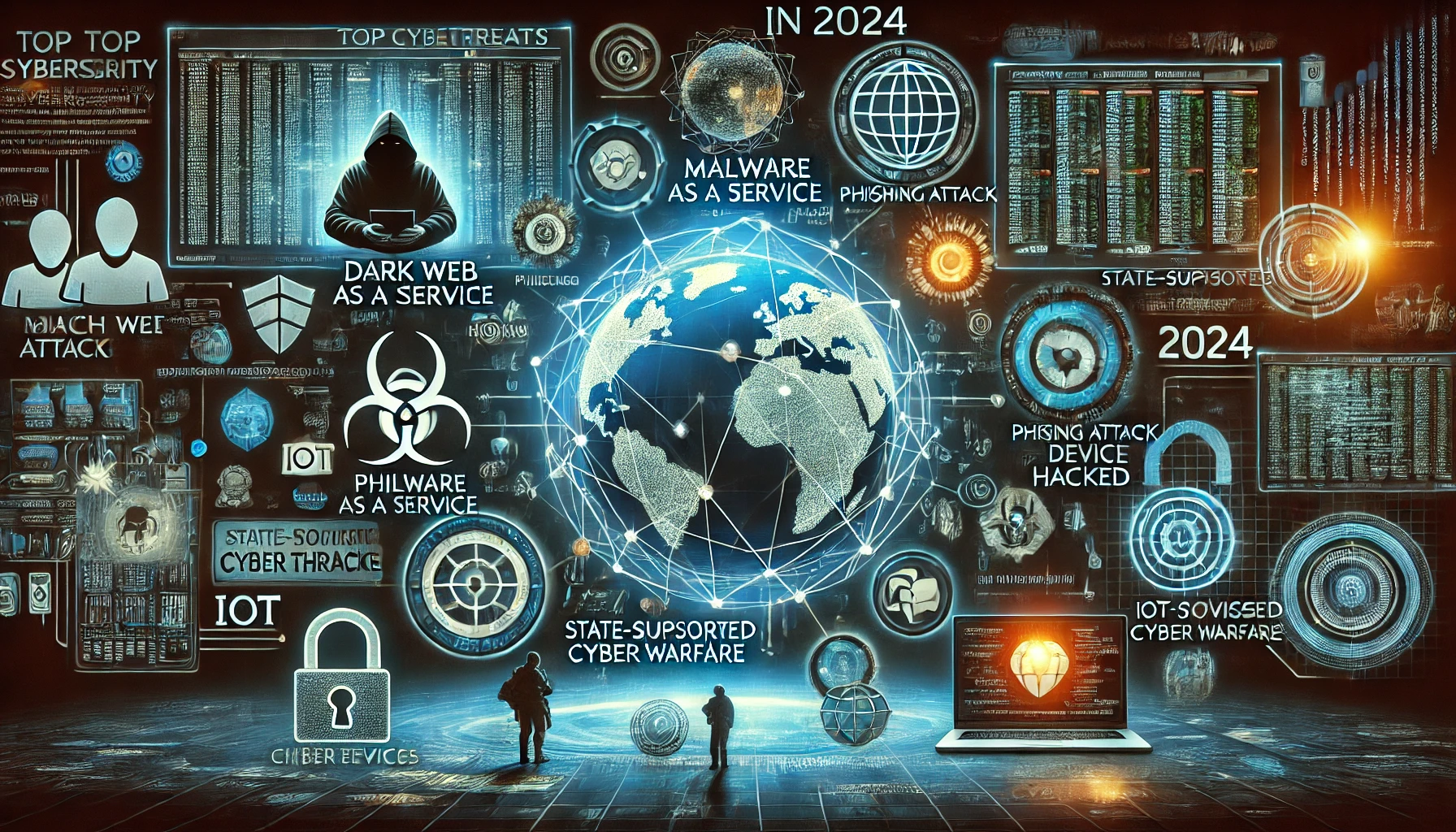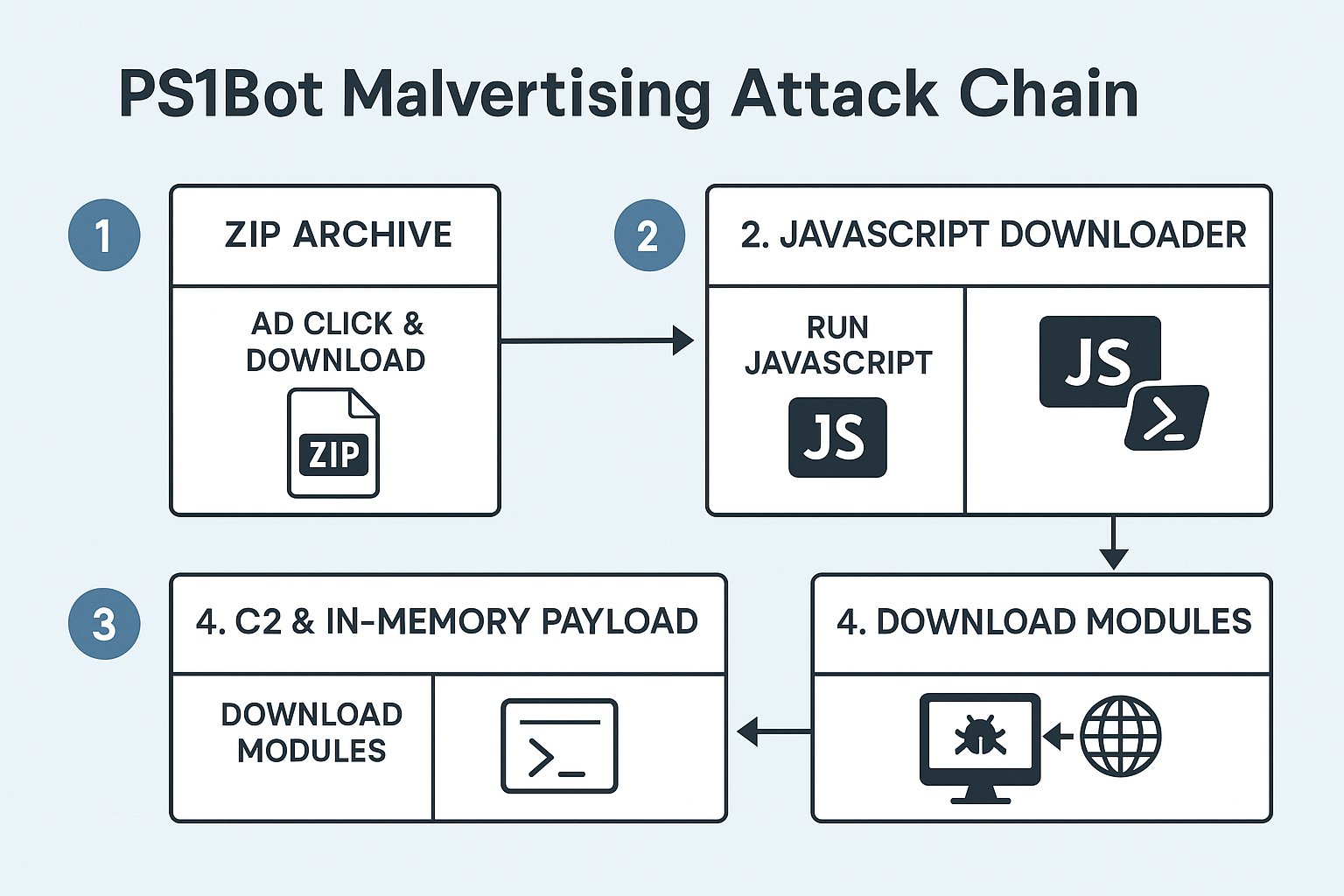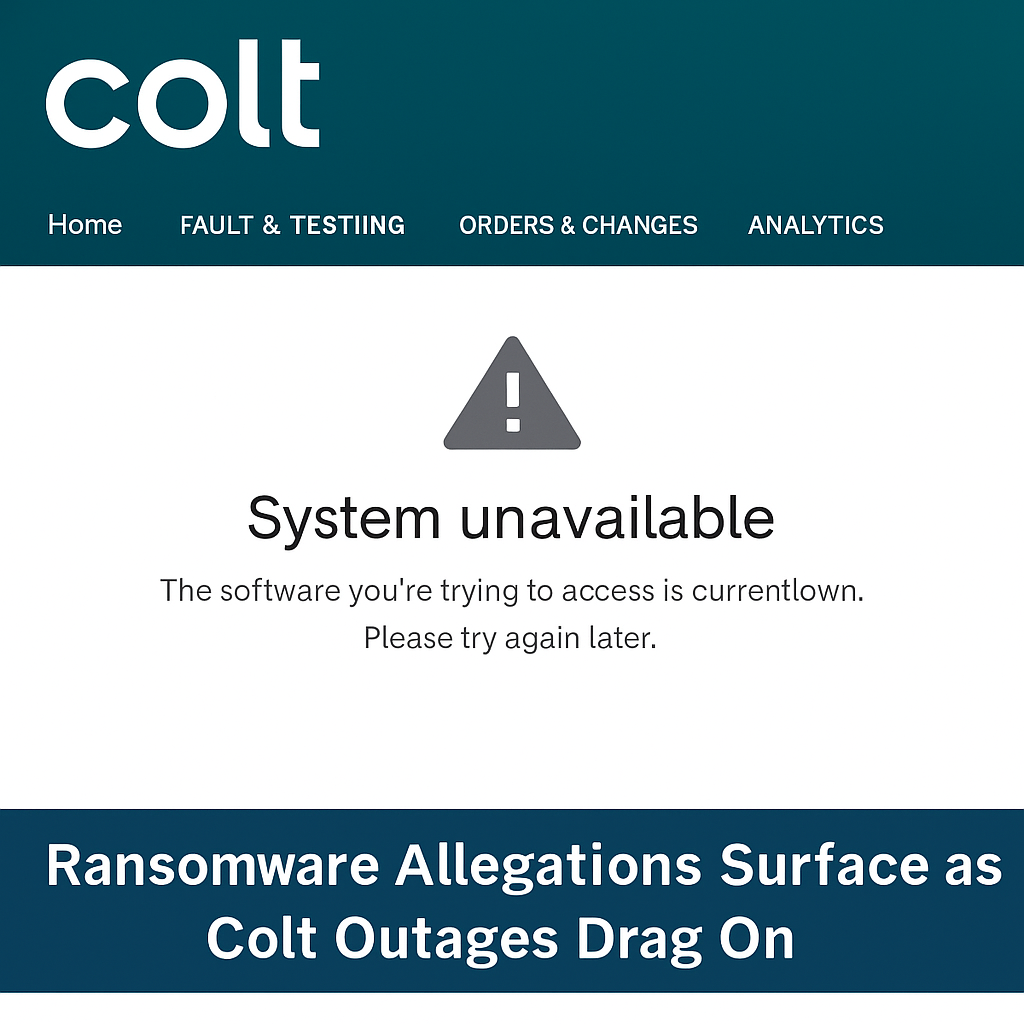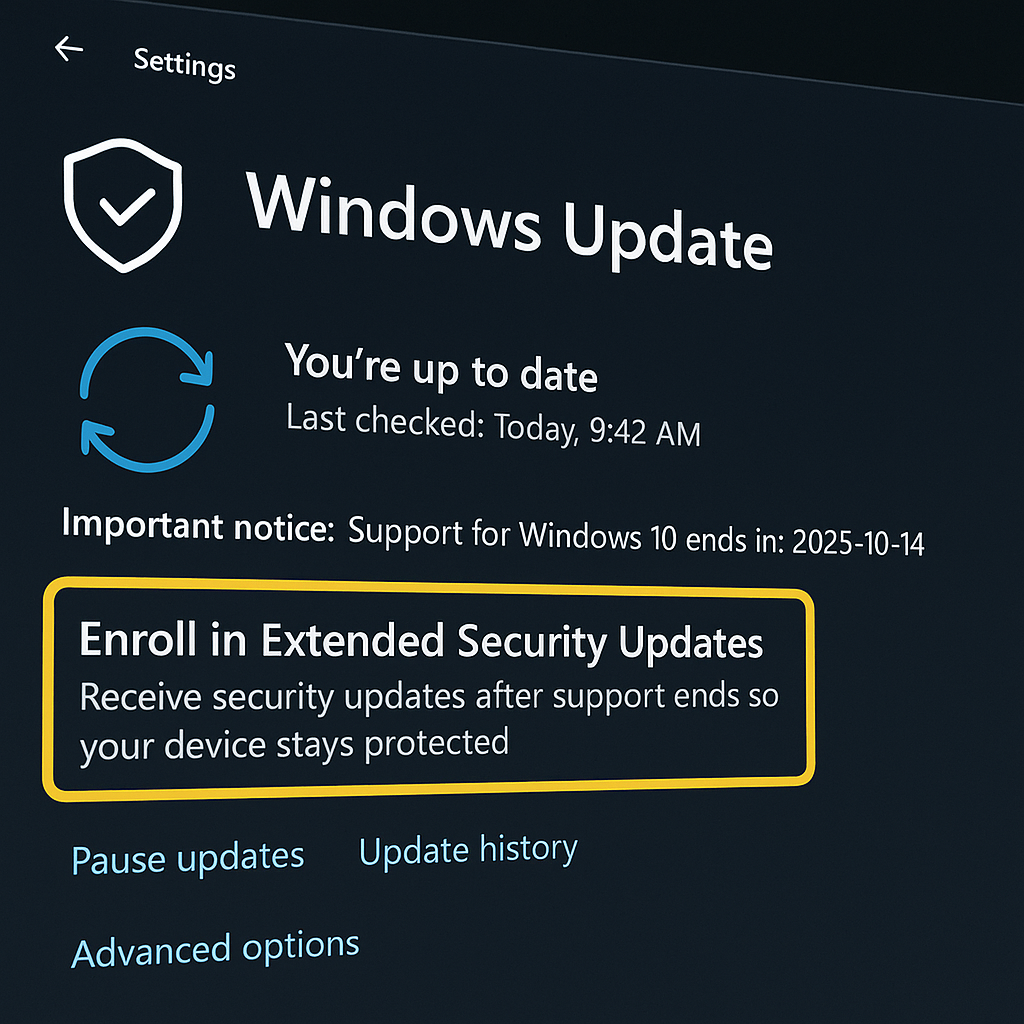Blog
Top Cybersecurity Threats in 2024: An Educational Overview

The cybersecurity landscape in 2024 has become increasingly complex, with threats evolving in sophistication and scale. Understanding these threats is crucial for individuals, businesses, and governments to protect sensitive information and infrastructure. Here’s an expanded overview of the top threats this year, focusing on how they work and what can be done to mitigate them.
1. Dark Web Activities
- Threat Details: The Dark Web is a hub for illegal activities, including the distribution of malware and stolen credentials. A significant trend is the rise of no-code malware, which requires minimal technical knowledge to deploy. There are also plug-and-play kits that come pre-configured for launching attacks and even include customer support.
- Fileless Attacks: Attackers use credentials purchased on the Dark Web to access systems without deploying traditional malware, leaving little to no trace.
- Zero-Day Exploits: Zero-day brokers on the Dark Web sell undisclosed software vulnerabilities to multiple buyers, making it challenging to defend against these threats.
- Mitigation: Organizations should consider monitoring the Dark Web through professional services to identify and respond to potential threats proactively(TechRepublic).
2. Malware as a Service (MaaS) and Hackers-for-Hire
- Threat Details: MaaS has grown with platforms offering a variety of malware and tools. These platforms have intuitive user interfaces and automation features, making them accessible to attackers with minimal skills. Hackers-for-hire services are also on the rise, allowing clients to outsource cyberattacks.
- Implications: This trend lowers the barrier to entry for cybercrime, potentially leading to a surge in both the number and sophistication of attacks.
- Mitigation: Organizations should implement layered security solutions to detect and block malware. Employee education on social engineering tactics and regular data backups are essential defenses(TechRepublic).
3. Modern Phishing
- Threat Details: Phishing attacks have become more personalized and sophisticated, leveraging AI to automate and customize messages. Traditional mass-mailed generic messages are being replaced by targeted campaigns, including deepfake technology.
- Implications: These attacks trick victims into revealing sensitive information or clicking on malicious links, which can lead to significant data breaches.
- Mitigation: Organizations must invest in tools to detect AI-generated content and run phishing simulations to train employees in recognizing and responding to phishing attempts(TechRepublic).
4. IoT and Industrial IoT Attacks
- Threat Details: IoT and Industrial IoT devices are increasingly targeted due to their ubiquity and often limited security. Attacks include leveraging vulnerabilities for distributed denial-of-service (DDoS) attacks, data theft, and operational disruptions.
- Supply Chain Vulnerabilities: Attackers exploit vulnerabilities in the supply chain and firmware updates, making these devices a weak link in cybersecurity.
- Mitigation: Organizations should implement secure coding practices, regularly update software and firmware, and use strong authentication protocols. Monitoring networks for suspicious activity and adopting zero-trust security models can also help isolate compromised devices(TechRepublic).
5. State-Sponsored Attacks
- Threat Details: Nation-state actors are increasingly conducting cyberattacks to achieve political and strategic objectives. These attacks often target critical infrastructure, steal sensitive information, and disrupt essential services.
- Examples: In 2023, there was an escalation of nation-state-supported cybercriminal activity from countries like North Korea and Russia, targeting international systems and infrastructure.
- Mitigation: Organizations need multilayered defenses, including sophisticated cybersecurity solutions, threat intelligence monitoring, and robust incident response plans. Collaboration with government and law enforcement agencies is also crucial(TechRepublic).
6. Advanced Cyber Threats
- Formjacking: Involves injecting malicious code into online forms to steal payment information, particularly targeting e-commerce sites.
- Rogue Software and Malvertising: Fake software masquerading as legitimate applications to harm or steal data, often distributed through deceptive ads.
- Keyloggers and Fileless Malware: Software that records keystrokes to steal information and malware that resides in memory, making detection challenging.
- Botnets and Cloud Jacking: Networks of infected devices used for coordinated attacks, and compromising cloud services to exploit resources.
- Mitigation: Regular updates, security patches, and advanced endpoint protection can help defend against these threats. Organizations should also employ secure coding practices and network monitoring(TECKPATH).
7. Emerging Threats
- Deepfake Technology: Using AI to create realistic fake videos or audio recordings, posing risks for deception and misinformation.
- Synthetic Identity Fraud: Combining real and fake information to create new identities for financial fraud.
- Voice Command Attacks: Exploiting voice-activated systems using recorded or synthesized voices to carry out unauthorized actions.
- Mitigation: To counter these emerging threats, organizations need to invest in advanced detection tools, implement multi-factor authentication, and provide regular training on security best practices(TECKPATH).
Educational Takeaway
The evolving landscape of cybersecurity threats in 2024 requires a proactive and informed approach. Key strategies for mitigation include:
- Employee Education: Regular training on recognizing and responding to cyber threats.
- Layered Security Solutions: Implementing multi-layered security defenses to detect and prevent attacks.
- Zero-Trust Security Models: Adopting zero-trust principles to minimize the impact of breaches.
- Regular Updates and Monitoring: Keeping software and systems up-to-date and actively monitoring for suspicious activity.
By understanding these threats and implementing comprehensive security measures, individuals and organizations can better protect themselves in the digital age.
Blog
Morocco Sets Sights on 70% 5G Coverage by 2030 With New License Launch

RABAT — July 26, 2025
In a landmark step toward digital transformation, Morocco’s National Telecommunications Regulatory Agency (ANRT) has officially launched the bidding process for 5G licenses, inviting national and international telecom operators to help deliver 25% population coverage by 2026 and 70% by 2030.
5G Strategy to Power FIFA World Cup and Beyond
The initiative aligns with Morocco’s preparations to co-host the 2030 FIFA World Cup and its broader Maroc Digital 2030 agenda. “This is about more than faster networks—it’s about our national future,” said Driss El Yazami, policy advisor at the Ministry of Digital Transition.
Highlights of the 5G Deployment Plan
- Initial rollouts in Casablanca, Rabat, Marrakech, and Tangier
- Smart infrastructure integration in stadiums and airports
- Spectrum allocation in 3.5GHz and mmWave bands
- Coverage expansion to underserved rural regions
From Urban Startups to Rural Farmers: 5G’s National Reach
5G is expected to revolutionize Moroccan society. Students will gain access to virtual classrooms, remote clinics will offer telemedicine, and farmers can deploy smart sensors. “Connectivity is empowerment,” said Amina El Mahdi, a tech entrepreneur in Fez.
Economic Impact and Cybersecurity Measures
The Ministry of Finance predicts 5G will boost GDP by 1.5% by 2030. All operators must meet strict cybersecurity, data localization, and interoperability standards monitored by ANRT and the National Cybersecurity Directorate.
2030 World Cup: Smart Stadiums and Global Broadcasts
With over 1.5 million visitors expected, 5G will support crowd management, mobile ticketing, HD broadcasts, and fan engagement zones across Moroccan host cities.
5G infrastructure being deployed in Morocco’s major cities ahead of FIFA 2030.
Blog
Critical Cyber Breach in Tunisia: Government Systems and Banks Hacked, Confidential Data for Sale

A coordinated cyberattack led by Moroccan hacker Jokeir 07x and groups Dark Hell 07x and Dr. Shell 08x compromises key Tunisian institutions, exposing government systems, banking infrastructure, and personal data to global exploitation.
Tunis, July 2025 — In an alarming escalation of cyber threats across North Africa, Tunisia has become the latest victim of a highly organized and devastating cyberattack. Orchestrated by Moroccan threat actor Jokeir 07x, in partnership with the groups Dark Hell 07x and Dr. Shell 08x, the operation has compromised critical national infrastructure—from government domains to private financial institutions.
“This is not just a defacement campaign—it’s full infrastructure penetration,” declared Jokeir 07x on Telegram.
The targets include the Ministry of Finance, Bank of Tunisia, BTK, and the Tunisian Academy of Banking and Finance, among others. The attackers claim full access to internal systems, including emails, financial records, developer platforms, and sensitive citizen data.
🏛️ Government Domain Breached: Ministry of Finance
The domain finances.gov.tn was infiltrated through 16 high-risk subdomains such as auth., gitlab.intra., mail., and login-tej. According to hacker statements, these allowed access to:
- Internal recruitment systems
- Budgetary information
- Developer repositories
- Administrative emails
This level of penetration indicates control over Tunisia’s digital authentication infrastructure and DevOps environment, raising severe concerns for national cybersecurity.
🏦 Banking Sector Compromised and Data Sold
Several banks were also impacted:
- Bank of Tunisia (bt.com.tn):
- Full customer database allegedly available for $4,000
- Individual bank accounts offered at $100
- 5-account bundles sold for $450
- BTK Bank (btknet.com) and Academy of Banking and Finance (abf.tn) also suffered complete breaches, including control over the sites and underlying systems.
The incident signals not just a data breach but the active commercialization of sensitive financial information on the dark web.
🔍 Technical Breakdown: How It Happened
Cybersecurity analysts have pointed to multiple failure points within Tunisia’s digital infrastructure:
- Web Application Vulnerabilities:
- SQL Injection
- File Upload flaws
- XSS
- Remote File Inclusion (RFI)
- SSO and Mail System Exploitation:
- Session hijacking likely
- Weak session/cookie management
- GitLab Exposure:
- Unauthorized access to internal GitLab revealed API tokens, credentials, and system architecture
- Lack of Security Infrastructure:
- No evidence of WAF, IDS, or SIEM defense
- No active monitoring or response systems
- Inadequate Data Protection:
- Absence of encryption, data masking, or tokenization
- Entire banking datasets available in plain text
⚠️ The Fallout: Trust, Security, and Reputation
This attack lays bare the vulnerabilities in Tunisia’s cyber defenses, damaging public trust in both government institutions and the banking sector. The country’s financial and administrative data has now surfaced on international black markets, with potential long-term repercussions for national security and economic stability.
💡 Urgent Recommendations for Recovery and Reform
Cybersecurity professionals are urging Tunisia to immediately:
- Establish internal SOC (Security Operations Centers)
- Mandate routine penetration testing
- Enforce multi-factor authentication (MFA)
- Implement end-to-end data encryption
- Audit and secure GitLab instances
- Conduct staff training on social engineering threats
- Deploy real-time code and data monitoring
“Being hacked is not the shame—failing to learn from it is,” noted a Tunisian cybersecurity analyst. “The future belongs to those who invest in digital resilience, not legacy infrastructure.”
Blog
Cloud Wars 2025: Full Breakdown of Azure, AWS, and Google Cloud Services You Need to Know
As cloud computing reshapes digital infrastructure, this side-by-side comparison of services across Microsoft Azure, Amazon Web Services (AWS), and Google Cloud Platform (GCP) empowers IT professionals and organizations to make informed decisions.
Cloud Wars: Breaking Down the Giants
In today’s digital-first world, cloud computing isn’t just a trend—it’s the backbone of enterprise IT. Whether you’re a startup deploying an app or a global corporation migrating legacy systems, choosing the right cloud provider can make or break your operations. A newly circulated Cloud Services Comparison Cheatsheet provides an invaluable visual breakdown of offerings from Microsoft Azure, Amazon Web Services (AWS), and Google Cloud Platform (GCP), the three dominant players in the cloud arena.
Technical Deep Dive: Key Service Categories Compared
This infographic categorizes over 25 essential cloud services and maps each across Azure, AWS, and GCP equivalents. Here’s what stands out:
1. Compute Services
- Azure: Virtual Machines
- AWS: EC2 (Elastic Compute Cloud)
- Google Cloud: Compute Engine
These services provide scalable virtual server environments, with options for predefined or custom machine types. Azure and AWS offer more mature ecosystems with hybrid cloud integrations, while GCP emphasizes fast boot times and sustained-use discounts.
2. Object Storage
- Azure Blob Storage
- Amazon S3
- Google Cloud Storage
All three services allow you to store large amounts of unstructured data. AWS S3 is known for its advanced features (like S3 Glacier), while Azure Blob integrates well with Microsoft services, and GCP offers multi-regional redundancy by default.
3. Serverless Computing
- Azure Functions
- AWS Lambda
- Google Cloud Functions
Serverless solutions allow developers to execute code without managing servers. AWS Lambda leads in ecosystem maturity, while Azure and Google offer solid integrations with their respective developer tools.
4. Content Delivery Networks (CDNs)
- Azure CDN, AWS CloudFront, and Google Cloud CDN
All three platforms offer global distribution of content to reduce latency. AWS CloudFront is widely adopted in large-scale enterprise environments, while Google leverages its backbone network to deliver high-speed content.
Security & Identity Management
Cloud security remains a priority as data breaches and compliance requirements escalate.
- Identity and Access Management (IAM) is offered across platforms with Azure Active Directory, AWS IAM, and Google Cloud IAM.
- Key Management Services (KMS) ensure secure handling of encryption keys across all three.
- Compliance tools like Azure Trust Center, AWS Cloud HSM, and Google Cloud Security help enterprises adhere to global regulations like GDPR, HIPAA, and ISO/IEC.
Specialized Services: AI, Containers, and Analytics
- Analytics: Azure Stream Analytics, Amazon Kinesis, and Google Dataflow enable real-time data processing.
- Containers: Azure Kubernetes Service (AKS), Amazon EKS, and Google Kubernetes Engine (GKE) support modern container orchestration.
- Automation: Each provider supports automation—Azure with Azure Automation, AWS with OpsWorks, and GCP with Deployment Manager.
Notable Differences
Some categories reveal gaps:
- Google Cloud lacks direct equivalents for services like DNS management (Route 53, Azure DNS) or cloud notifications (AWS SNS, Azure Notification Hub).
- Azure leads in hybrid cloud features due to its integration with Windows Server and on-prem tools.
- AWS offers the broadest service portfolio, making it ideal for complex multi-cloud or global enterprise setups.
-

 data breaches7 days ago
data breaches7 days agoALERT – Stop What You’re Doing & Update WinRAR Now
-

 data breaches5 days ago
data breaches5 days agoHackers Claim Full Network Takeover at Royal Enfield
-

 data breaches1 week ago
data breaches1 week agoLeaked Logins Are the New Zero-Days—Here’s How Attackers Exploit Them
-

 data breaches6 days ago
data breaches6 days agoFrom VPN to FortiManager: Attack Pattern Suggests Preparation for New Exploit
-

 data breaches4 days ago
data breaches4 days agoPennsylvania AG’s Website, Email Taken Down in Security Incident
-

 International7 days ago
International7 days agoFrom Rabat to the Sahel: Moroccan Builders Lead Africa’s Largest Road Project
-

 International1 week ago
International1 week agoEspionage in the Maghreb: Algerian-Spanish Deal to Counter Morocco Unearthed
-

 data breaches5 days ago
data breaches5 days agoNew PS1Bot Malware Uses Fileless PowerShell for Data Theft







